This is the first of three features that I will be doing this pre-season regarding an analysis of fantasy Wide Receivers.
In the two future segments I will analyze Sophomore Wide Receivers (from the Class of 2022) and look closely at what I call the QB-to-WR Index.
In this feature, I will attempt to look at the empirical receiving data from 2022 (in terms of targets, receptions and fantasy points) to help build a model (or at least a starting point) for ranking the fantasy wide receivers headed into 2023.
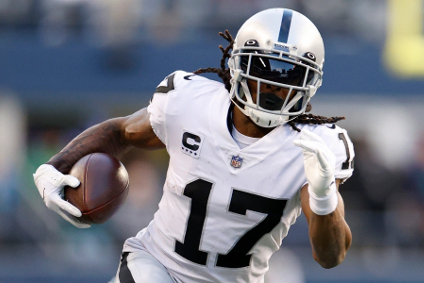
More specifically, this feature is built around a number of top-40 charts. My goal is to use the data represented in these tables to begin a guided tour that will hopefully get us to our destination: an initial ranking of fantasy wide receivers.
The charts include the final 2022 rankings of wide receivers in the following categories: Fantasy Points, Receptions, Targets, Team Share, Conversion Rate, and Fantasy Points Per Target.
Note that the tables below reference the 2022 team for which each player played last season.
Lets start by simply looking at the wide receivers who scored the most points in fantasy in 2022. Note that the point totals listed below represent both standard scoring (1.0 point for each yard rushing/receiving and 6 points per touchdown) as well as point per reception (PPR) -- standard PLUS one bonus point per reception totals. The data is sorted by PPR.
Fantasy Points
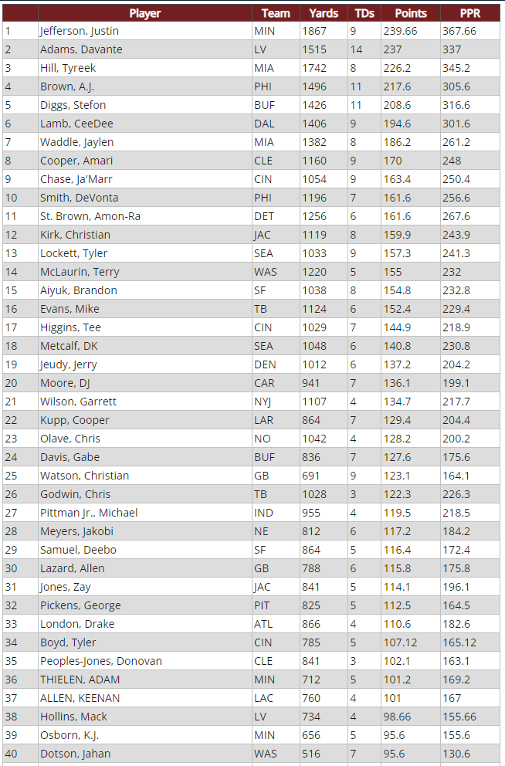
Observations:
There is nothing truly earth-shattering here, as when we look at the total numbers at a high level, we simply see the top 40 fantasy WRs from last season. Obviously most of these players will be high in the 2023 rankings with the presumption that they will have another successful fantasy season.
Aside from the usual studs, there were a number of surprise players such as Christian Kirk, Garrett Wilson and Chris Olave who all posted start-worthy numbers -- that is, finished as at worst a WR2 in 12-team leagues -- but were largely overlooked last year in fantasy drafts. Speaking of which... note that Gabe Davis did indeed finish as WR24 in standard formats, making him a genuine fantasy WR2 despite the perception that hw was a "bust" in 2022.
Some of the more disappointing players were DeAndre Hopkins, Keenan Allen and Darnell Mooney who were typically drafted with high selections in fantasy drafts yet seriously under-performed (in many cases due to injury).
Receptions
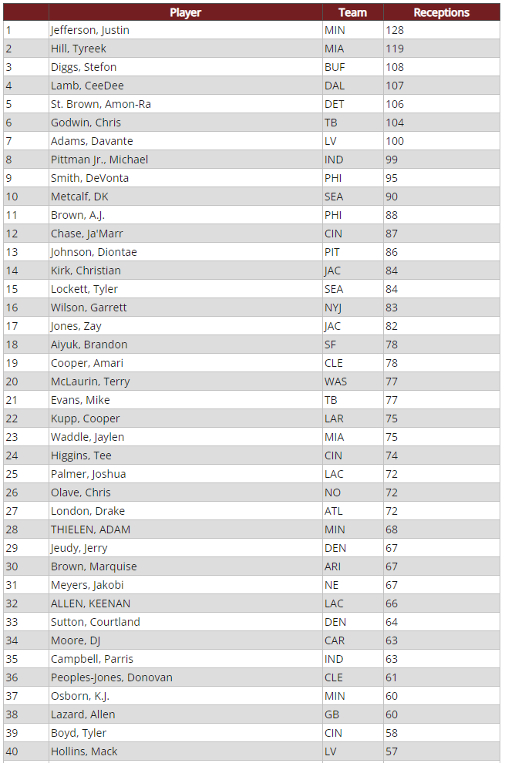
Observations:
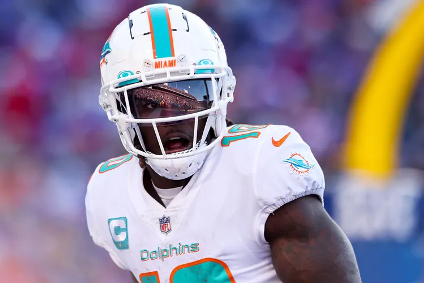
Receptions are key because not only do they represent opportunities for yards and TDs -- but they also directly correlate to fantasy points in PPR (Point Per Reception) formats.
A good example of the variation in the two formats is Tyreek Hill who finished essentially 3rd (behind Justin Jefferson and Devante Adams) in our first chart in terms of standard scoring -- but was 2nd (well ahead of Adams) in receptions and also PPR scoring. That is, Hill's increase in volume made up for Adams being more productive last season. What this tells us is that a player like Hill is much more valuable in PPR formats than he is in standard formats.
Note that Jefferson was still the unquestioned top dog in both formats and reception totals.
What does that mean?
Make sure you look closely at the scoring rules in your league. If it is PPR then players like Jefferson and Adams are even more valuable. I am talking valuable enough to draft in the first round as opposed to waiting until the 2nd. Even a receiver like T. Hill is worth picking no later than early in the 2nd round in PPR formats.
Targets
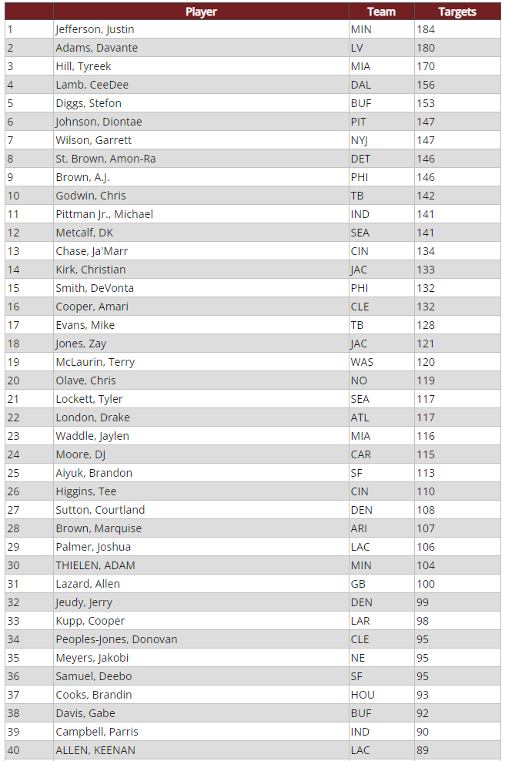
Observations:
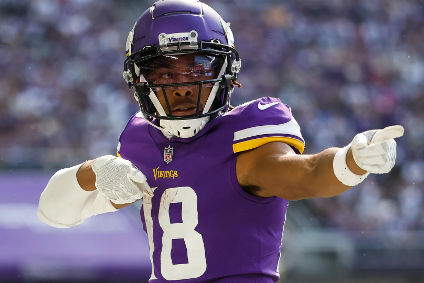
In a way, targets are even more interesting numbers to look at than receptions. I think of a reception as being the successful outcome of a target. Targets represent opportunities.
The mantra in fantasy, of course, is not to assume that opportunity leads to production. While that is also true with the targets, of course, it makes sense that there is a direct correlation to receivers who were heavily targeted in the passing game with those who had strong fantasy seasons.
Diontae Johnson, Chris Godwin, Zay Jones, Drake London and Michael Pittman are the only receivers among our top 25 most-targeted, who did NOT also make the top 25 list in fantasy points scored.
From that perspective, these players had the most disappointing seasons of all, because the opportunities were there. Moreover, since they failed to produce on the volume of opportunities with which they were presented, there is a chance that they will see a significant decline in opportunities (targets) this year. Take Diontae Johnson. His situation may be unique given his huge volume with minimal results, but the point must be made that receivers who are targeted a lot (and may even catch high percentage of their targets) may not necessarily be fantasy studs.
Team Share
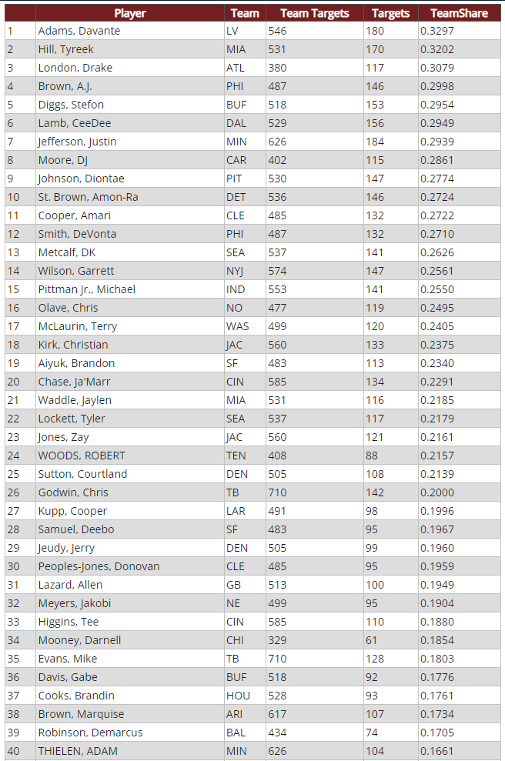
Observations:
I find this chart to be more interesting than necessarily useful from a fantasy perspective. What it does is emphasize how important that a given receiver was to his team in terms of the percentage of targets went his way.
What this does is emphasize not only which receivers were the favorite targets of their respective teams -- but which ones became the apple's eye of their quarterback.
It is not surprising to see at the top of the list Adams and Hill. What is a bit surprising in #3, Drake London who led Atlanta with over 30% of the team's targets.
I suppose the value from a fantasy perspective here lies in identifying those teams which may evolve into a more pass-friendly offense in 2023 or whose QB situation may be better.
I'll look at that more closely in a future installment on Taking a Look at the QB-to-WR Index. So be on the lookout for that segment in the next week or so.
Conversely, be careful to look closely at teams that added immediate reinforcements -- or players who have moved on. Keep a close eye on free agency to see what moves may have the greatest impact.
Conversion Rate
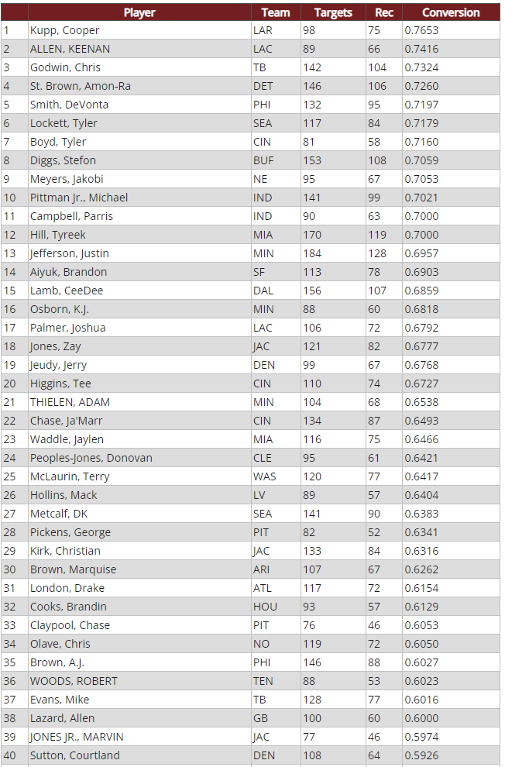
Observations:

Think of this as the list of receivers with the best batting average. That is, the receivers who converted the greatest percentage of their at-bats (targets) into hits (receptions). For this exercise, I have excluded players who did not have at least 75 targets.
I must admit that I was rather surprised to see the top 10 list. It is especially interesting that Kupp and Allen (both of whom had injury-shortened seasons) ranked 1-2 respectively. Probably a nice sign not to let the overall 2022 production from these two to scare you away. Interesting to note also that for the second year in a row, Godwin ranks in the top 3 here too.
Fantasy Points Per Target
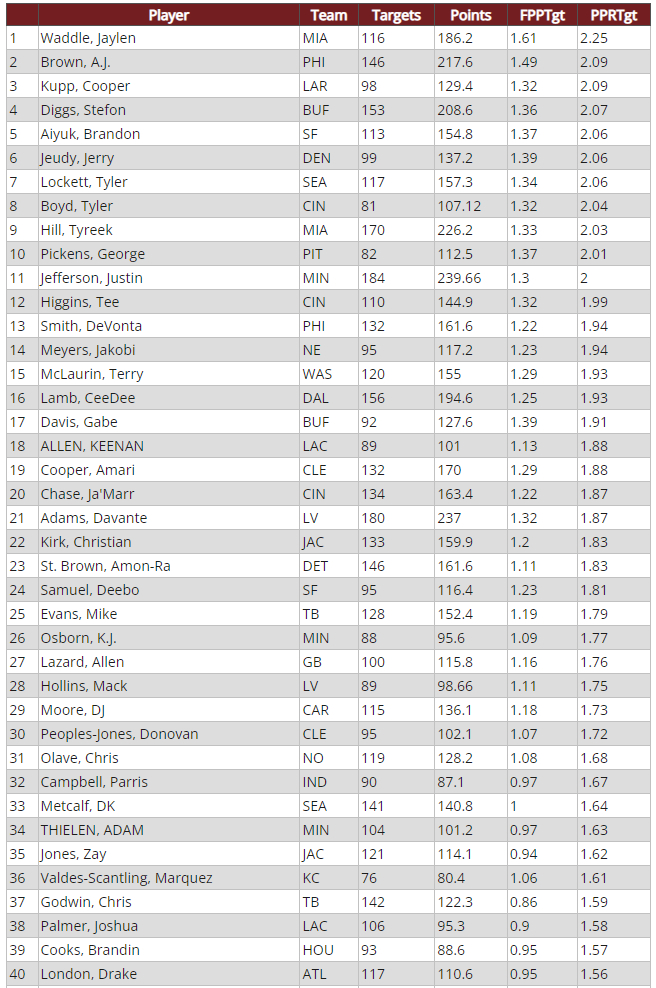
Observations:
The list above is for a minimum of 75 targets. The Points Per Target value was rounded to two digits to the right of the decimal, but all sorting was performed prior to the rounding -- and no two players had an identical value prior to the rounding. That is, there were no ties despite the identical values listed above -- and the players are all listed in the correct order.
After clarifying all that, I must say that this is one of my favorite statistics when looking at fantasy wide receivers as it truly measures which players made the most (fantasy points) of the opportunities presented to them (targets). The key to identifying fantasy relevance is to identify which players appear on this Fantasy Points Per Target chart as well as the Total Targets chart. This will present you with the list of players who operated at a high fantasy level due to both volume and production.
Using such a formula gives us the following players who had the highest combined score on both charts:
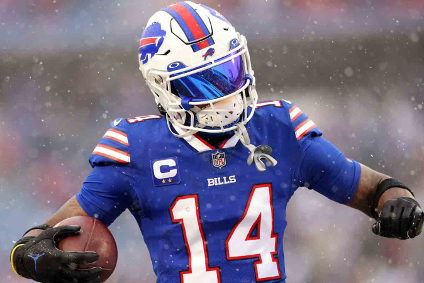
1. Diggs, Stefon
2. Brown, AJ
3. Jefferson, Justin
4. Hill, Tyreek
5. Lamb, CeeDee
6. Adams, Davante
7. Waddle, Jaylen
8. Lockett, Tyler
9. Smith, DeVonta
10. St. Brown, Amon-Ra
11. Aiyuk, Brandon
12. Chase, Ja'Marr
13. McLaurin, Terry
14. Cooper, Amari
15. Kupp, Cooper
16. Kirk, Christian
17. Jeudy, Jerry
18. Higgins, Tee
19. Evans, Mike
20. Metcalf, DK
21. Godwin, Chris
22. Meyers, Jakobi
23. Olave, Chris
24. Wilson, Garrett
25. Moore, DJ
26. Jones, Zay
27. Boyd, Tyler
28. Pittman, Michael
29. Pickens, George
30. Johnson, Diontae
31. Davis, Gabe
32. Lazard, Allen
33. Samuel, Deebo
34. Allen, Keenan
35. London, Drake
36. Thielen, Adam
Obviously this is far from scientific and fails to take other key factors (such as injuries, possibility of unusually bad/good season, new team, etc.) into account. But I think it represents an interesting and defendable baseline.